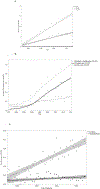Epidemiology and Outcomes of Young-Onset Esophageal Adenocarcinoma: An Analysis from a Population-Based Database
- PMID: 33328255
- PMCID: PMC7855414
- DOI: 10.1158/1055-9965.EPI-20-0944
Epidemiology and Outcomes of Young-Onset Esophageal Adenocarcinoma: An Analysis from a Population-Based Database
Abstract
Background: Esophageal adenocarcinoma is a lethal cancer with rising incidence. There are limited data in younger (<50 years) patients with esophageal adenocarcinoma. We aimed to assess time trends in the incidence and outcomes of "young-onset" esophageal adenocarcinoma using a population-based database.
Methods: We queried the Surveillance, Epidemiology, and End Results 9 database to identify patients with esophageal adenocarcinoma between 1975 and 2015. Patients were stratified into three age strata: <50, 50 to 69, and ≥70 years. Staging was stratified as localized, regional, and distant. Trends in incidence, disease stage, and survival were assessed in three periods (1975-89, 1990-99, and 2000-2015). Univariate and multivariate models were created to identify predictors of mortality.
Results: Esophageal adenocarcinoma incidence has increased in patients <50 years of age, with an annual percentage change of 2.9% (95% confidence interval, 1.4%-4.4%) from 1975 to 2015. Young-onset esophageal adenocarcinoma presented at more advanced stages (regional + distant) compared with older patients (84.9% vs. 67.3%; P < 0.01), with increasing proportion of advanced stages over the study period. These patients also experienced poorer 5-year esophageal adenocarcinoma-free survival compared with older patients (22.9%% vs. 29.6%; P < 0.01), although this finding was attenuated on stage-stratified analysis.
Conclusions: Young-onset esophageal adenocarcinoma, while uncommon, is rising in incidence. Concerningly, the proportion of advanced disease continues to increase. Young-onset esophageal adenocarcinoma also presents at more advanced stages, resulting in poorer esophageal adenocarcinoma-free survival.
Impact: Patients with esophageal adenocarcinoma younger than 50 years present at more advanced stages with higher esophageal adenocarcinoma-specific mortality compared with older peers. Current diagnostic and management strategies for young-onset esophageal adenocarcinoma may need to be reevaluated.
©2020 American Association for Cancer Research.
Figures


References
-
- Siegel RL, Miller KD, Jemal A. Cancer statistics, 2019. CA Cancer J Clin 2019;69:7–34. - PubMed
-
- Spechler SJ, Souza RF. Barrett’s Esophagus. New England Journal of Medicine 2014;371:836–845. - PubMed
-
- Rastogi A, Puli S, El-Serag HB, et al. Incidence of esophageal adenocarcinoma in patients with Barrett’s esophagus and high-grade dysplasia: a meta-analysis. Gastrointestinal Endoscopy 2008;67:394–8. - PubMed
Publication types
MeSH terms
Supplementary concepts
Grants and funding
LinkOut - more resources
Full Text Sources
Other Literature Sources
Medical

